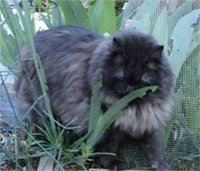Doing the cross-species hop
What allows a virus to begin infecting a new species?
This question concerns many people these days as we anxiously watch the skies. When will avian influenza obtain the capacity for human to human transmission?
It seems in the case in parvovirus, that a rapid mutation rate may be a key. If a virus can quickly mutate, some of the progeny might be better adapted to the new host.
HHMI news has a nice description of a fascinating study, recently published in the Journal of Virology, that extends work published last year in PNAS (1).
The authors look at the evolutionary changes that occured when the feline panleukopenia virus made the switch and began infecting dogs. Once the virus began to infect dogs, mutations began to appear more rapidly, paving the way for dog to dog transmission. It's an amazing and nicely done piece of work that helps illustrate why evolutionary studies are important.
 Or perhaps it's just a case of the cats getting their revenge.
Or perhaps it's just a case of the cats getting their revenge.
References:
1. L. Shackelton, C. Parrish, U. Truyen, and E. Holmes. 2005. High rate of viral evolution associated with the emergence of carnivore parovirus. Proc. Natl. Acad. Sci. 102:379-384.
Subject: Microbes
This question concerns many people these days as we anxiously watch the skies. When will avian influenza obtain the capacity for human to human transmission?
It seems in the case in parvovirus, that a rapid mutation rate may be a key. If a virus can quickly mutate, some of the progeny might be better adapted to the new host.
HHMI news has a nice description of a fascinating study, recently published in the Journal of Virology, that extends work published last year in PNAS (1).
The authors look at the evolutionary changes that occured when the feline panleukopenia virus made the switch and began infecting dogs. Once the virus began to infect dogs, mutations began to appear more rapidly, paving the way for dog to dog transmission. It's an amazing and nicely done piece of work that helps illustrate why evolutionary studies are important.
 Or perhaps it's just a case of the cats getting their revenge.
Or perhaps it's just a case of the cats getting their revenge.References:
1. L. Shackelton, C. Parrish, U. Truyen, and E. Holmes. 2005. High rate of viral evolution associated with the emergence of carnivore parovirus. Proc. Natl. Acad. Sci. 102:379-384.
Subject: Microbes
technorati tags: virus, microbiology

0 Comments:
Post a Comment
<< Home